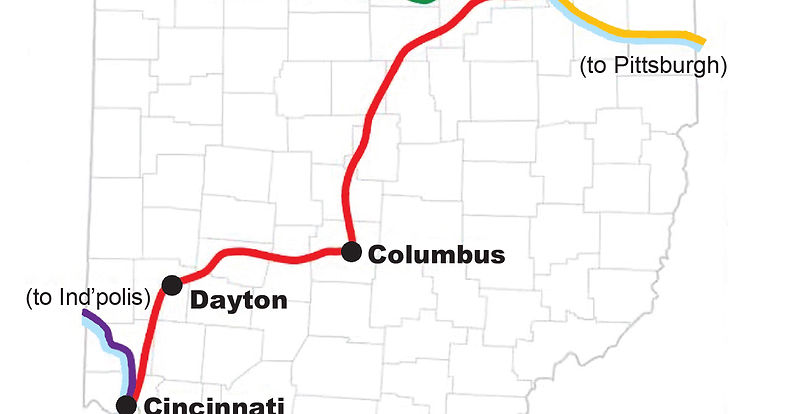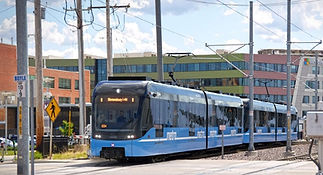
How many times have we seen hopes rise and fall and proposals come and go to improve how we move our people in Ohio? How many passenger rail and local public transit plans are nothing more than dusty studies on some agency's planning shelf?
The bi-partisan Infrastructure Investment and Jobs Act may have changed what has been a status quo of Ohio being the place where good rail and transit ideas and projects go to die. For once, there is serious funding on the table at the Federal level for both passenger rail and public transit. More importantly, we have public officials and agencies in Ohio not just taking notice of this first-ever funding pool, but actively supporting plans such as the Amtrak Connects US plan to greatly expand passenger rail in Ohio.
But the hard truth is there are zero funds at the state level for passenger rail and the current, small budget for the Ohio Rail Development Commission is directed entirely at freight rail projects. And Ohio has no dedicated source of funding for passenger rail or transit that can be used for a state match for grants offered by the Federal Railroad Administration (FRA) or the Federal Transit Administration (FTA).
Public transit funding remains both a biennial political football in the Ohio General Assembly and still inadequate because it must be debated every two years as part of the mammoth ODOT (Ohio Dept. of Transportation) budget. It took an intense effort by transit advocates, including All Aboard Ohio, to get legislators to retain an increase in general revenue funding for transit that was passed by the previous session of the General Assembly. That debate gets underway again next year.
And yet as Ohio sees an improving economy and major companies locating and expanding in our state, we face a growing crisis: the inability to connect new and existing employers with Ohio’s skilled workforce by any means other than by car.
When Intel Corporation announced it would build two computer chip manufacturing plants near the Columbus suburb of New Albany, the first response from state transportation officials was that they would have to increase lane capacity on State Route 161 and build two brand new interchanges. But what about rail and public transit connections as an option? (Cue the crickets) Not a mention.
It took an op-ed from All Aboard Ohio’s Board Chair, Theresa Allen, to help get at least a conversation started. Thankfully that conversation is growing among local planning agencies and the Central Ohio Transit Authority. Even local media have picked up the issue and are asking questions. That’s good.
But Ohio should not have to be in crisis response mode. We should have a rail and public transit development structure that recognizes and responds to the need to connect Ohioans with jobs and education and to move a skilled workforce without having to always depend on driving a car.
This becomes more critical as we consider both climate impacts and the fact that the annual national average to own and operate a car is now over $10,000 and perhaps more in some parts of Ohio. Simply adding highway lanes and new interchanges is not the answer. And it does nothing for skilled job seekers who don’t own a car, cannot afford the fuel costs of a long commute, or cannot drive.
This is why All Aboard Ohio believes that Ohio’s next Governor must advance a critical change to our transportation development system: a cabinet-level Department of Rail and Public Transportation with a dedicated source of funding support.
This may seem a radical move, but it really isn’t. Ohio can find an excellent model in the state of Virginia’s own Department of Rail & Public Transit (DRPT). What’s more, within Virginia’s DRPT there’s now a new and highly effective Virginia Passenger Rail Authority that is now advancing a growing network of popular passenger rail corridors and is about to develop another cross-state corridor. (Link to more at: https://www.drpt.virginia.gov and https://vapassengerrailauthority.org )
We aren’t asking Ohio’s next Governor to re-invent the wheel here. We are just stating the obvious, that rail and public transit funding and development need to be on an equal plane with how our state develops highways and roads.
Ohio needs better transportation options, whether it’s developing passenger rail projects to connect our cities, local rail and/or rubber tire-based transit projects like Bus Rapid Transit corridors, or safe, separated bikeways and safe walkable communities. The time is past for these important options to be considered second-tier priorities.
We need more and better options to travel in Ohio, whether it’s to connect with jobs, education, health care, tourism or just everyday wants and needs. The status quo can’t and doesn’t meet these new and growing demands for greater mobility.
Ohio needs a transportation portfolio that develops all options. And we need it soon!
ABOUT ALL ABOARD OHIO
All Aboard Ohio is a non-profit, member-based organization dedicated to promoting improved public transportation and passenger rail service throughout the state.
Founded in 1973 and incorporated as a registered 501c-3 in 1987, All Aboard Ohio has spent more than 50 years advocating, educating, and working towards our goal of a connected Midwest
All Aboard Ohio is a 501c-3 nonprofit with over 50 years of advocacy work, advocating for improved public transportation and passenger rail service in the Midwest
©2025 by All Aboard Ohio
Get in Touch
3136 Kingsdale Center,
#112 Columbus, OH 43221
Federal Tax ID: 31-1066182









